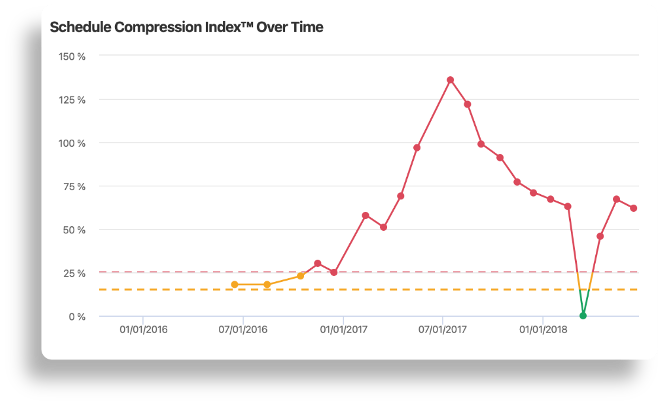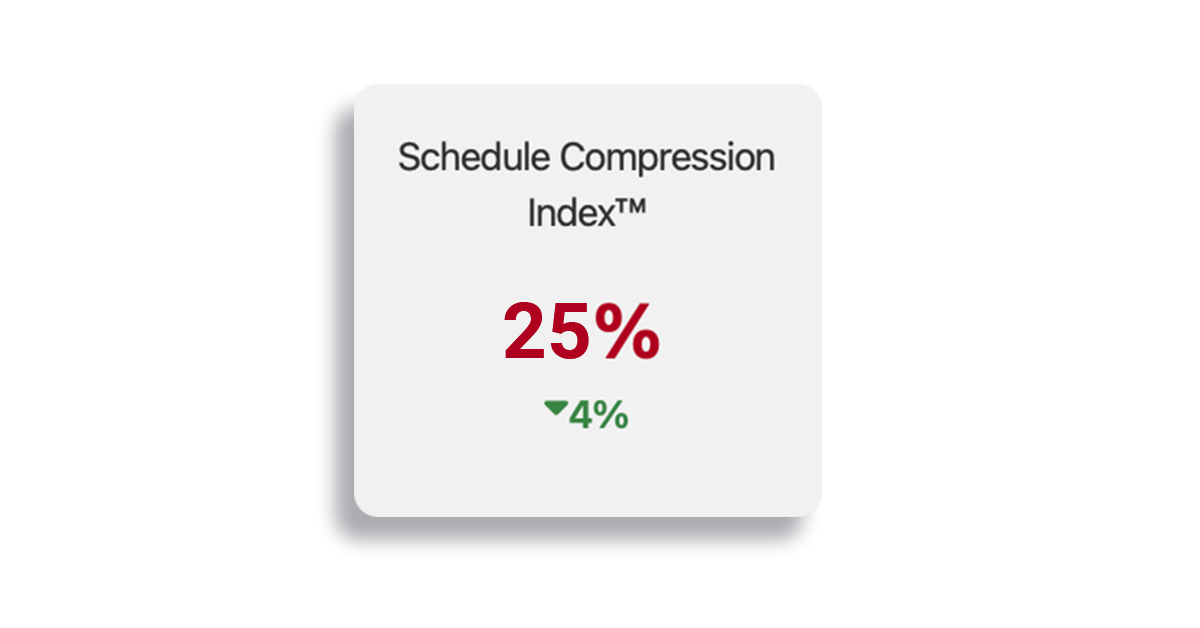Making sense of all of your data from all of your projects can feel like trying to understand a foreign language. But, when we break it down into steps, it starts to make a lot more sense.

- News
Decoding Schedule Compression: Balancing Efficiency and Risk
Let’s face it: delays are inevitable–there are simply too many moving parts involved during any multi-million dollar venture. As a result, frequent schedule changes are the norm. How you alter your schedule is up to you. Yet, one of the most common delay mitigation strategies is through schedule compression.
Compressing CPM schedules to mitigate historic impacts is an effective tactic for keeping projects within their prospective scope. However, doing so also tends to add an abundance of unnecessary risk.
What Is Schedule Compression?
Compression (trade stacking, crashing, acceleration, etc.) occurs when decisions are made to shorten a project’s duration without changing its scope. This means the remaining amount of work needs to be completed in less time than initially planned.

Compression is indicative of schedule changes as it typically results from:
- The decision to push off future work with float.
- Accelerating critical or near-critical path activities in an attempt to mitigate historical delay.
- The absence of crew logic.
While this may seem like an ideal recovery method for common scheduling pitfalls, it is widely misunderstood. Consequently, it should only be used when the level of compression is achievable.
Looking at the Data
By analyzing over 45,000 CPM schedules, SmartPM found some interesting data.
- By the project midpoint, fewer than 12% of schedules match their intended progress goals.
- Schedule Compression is prevalent in over 60% of projects.
With fewer than 12% of schedules meeting their intended progress goals, it makes sense that, on average, more than half of the projects (60%) require schedule crashing to reach their intended goals. However, doing so often leads to an unachievable plan.
Compression quantifies extra workload, helping gauge whether end dates are feasible without excessive strain on your workforce. When it is at its highest, problems arise. Every delay, be it material delivery or workforce-related, begins to stack up. The schedule tightens, and suddenly, there’s a realization that the project won’t finish on time. This phase is where most claims originate. Stakeholders start pointing fingers at each other about what went wrong during this period, questioning critical activities, and examining the Time Impact Analyses (TIA) that may have pushed the end date.
How Much Is Too Much?

The Schedule Compression Index™ Over Time Graphic above displays a fluctuation in compression indexes throughout the project lifecycle. A sharp peak happens around mid-2017, followed by a significant drop and stabilization.
The dramatic rise and subsequent drop in the compression index suggests that extensive changes were made to the schedule, possibly in response to unforeseen challenges or setbacks. Furthermore, a compression index of 125% implies an impractical workload towards the end of the project. With such a high compression rate, the resources and adjustments necessary to stay on track are impractical.

Any compression over 25% is problematic. It denotes an attempt to achieve 25% more work in the remaining project duration. If this remains unaddressed, the project team might find themselves working extra hours or even weekends to meet the target completion date.
With this in mind, it is crucial for project teams to monitor schedule changes throughout the project to manage time and budgets more effectively. Before executing any changes, evaluate their effects regarding schedule compression and feasibility. This step leads to more informed decisions, ensuring the changes won’t negatively impact the project’s timeline, resources, or deliverables.
Risks Associated with Compression:
Impacts on Schedule Quality and Viability
- Over-compressing a schedule leads to unrealistic timelines and increases the likelihood of missing critical milestones, potentially compromising project viability.
Lower Productivity
- High-intensity work periods can lead to burnout, decreasing overall team productivity rather than improving it.
Impacts on Quality and Safety
- Accelerating work to meet condensed timelines often results in neglected safety standards and reduced work quality, raising the likelihood of accidents and errors.
Further Delays and Overruns
- Trying to accomplish additional work in less time can inadvertently lead to additional delays and costs due to unrealistic expectations and additional resource requirements.
Claims and Disputes
- Heightened acceleration often leads to unmet deadlines, creating a hotbed for conflicts as stakeholders assign blame for delays. This scenario escalates the likelihood of legal disputes and liability concerns.
Managing Schedule Acceleration: Risks and Rewards
While some project teams are okay with making a massive volume of changes to logic and durations to achieve completion dates, it requires deliberate monitoring so as not to drive projects “off the rails.”
At the end of the day, the higher the compression, the greater the risk. Frankly, it is unrealistic to assume things will happen faster in the future without the same issues from the past arising on a much shorter timeline.
If you’d like to automatically know your compression index throughout your project’s lifecycle, fill out the form below. We’d be happy to give you the insight you need for smoother project execution.
RELATED STORIES

Making Construction Data Analytics Easier to Understand
Making sense of all of your data from all of your projects can feel like trying to understand a foreign language. But, when we break it down into steps, it starts to make a lot more sense.

Overcoming Confirmation Bias in Construction Project Management
Confirmation bias can be particularly problematic in project and schedule management, where decisions must be based on accurate and comprehensive information.

Top Construction Scheduling Software in 2023
SmartPM’s recognition as a top construction scheduling software in 2023 attests to the immense value in automated project controls.

Putting the ‘Smart’ in Project Management with Project Controls
Project controls are not just a subset of project management; they are its backbone, focusing on meticulous monitoring and analysis.

